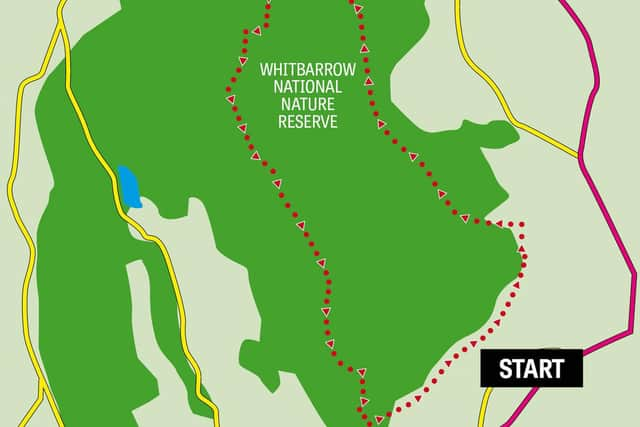A promise of greater wonders to come


Frequent visitors to the Lake District will know Whitbarrow by sight if not name as it is the first feature of note to be seen on the road to Newby Bridge – a great lump of limestone rising abruptly over the flat lands of the Kent Estuary. It acts as the Lake District’s card of introduction – a promise of greater wonders to come. Most visitors will see it and then continue to drive on past intent on seeing the greater wonders and bagging their Wainwrights.
Wainwright does describe the fell in “The Outlying Fells of Lakeland” which he published in 1973 as a kind of addendum to the seven volumes comprising “A Pictorial Guide to the Lakeland Fells”. This was purposely written “for old age pensioners and others who can no longer climb the high fells but can still, within reason, potter about on the short and easy slopes and summits of the foothills.”
Advertisement
Hide AdAdvertisement
Hide AdThe Thursday group of the Dotcom Walkers is entirely composed of OAPs (as is the Tuesday group). Right from the start - 11 years ago - it has had a more challenging programme than the Tuesday group. If it had a motto it would be “longer, higher and no pub lunch”. We can still climb and enjoy the high fells but from time to time walk the outliers. Malcolm who organises the Thursday group led us on the route described below.


Walk Facts
Start/Finish: Raven’s Lodge LA8 8EU. Travelling west on the A590 pass the turn for the A5074 and then turn next right. Follow the lane as it bends left then turn right on another lane leading to the farm - Raven’s Lodge. After passing the main complex arrive at a small car park (5-6 cars).
Distance: 6 miles
Time: 3 - 4 hours
Grade: Moderate
Map: OS OL7 The English Lakes South-eastern area
Directions
The general plan of the walk is quite straightforward - following forestry footpaths to the northern end of Whitbarrow and then completing the climb to the ridge follow this to southern end. The ridge part is unproblematic - more care with navigation is required in the woods.
From the car park continue along a broad farm track for ½ mile to Rawsons, a farm complex. Passing a large barn turn left to pass the farmhouse and join a footpath leading into trees. This zig-zags upwards and then as it straightens out continue for 200yds to a junction of tracks. Bear right through a gateway to complete this initial climb. Above Watson’s Wood the track levels out and continues for almost a mile and half in a north westerly direction to the northern end of Whitbarrow. There’s not much to assist you in terms of features as this section of the walk is heavily wooded. After perhaps 40 minutes of walking on reaching a junction of footpaths as indicated by waymark signs (yellow arrows) go left on a path that soon recommences the climb to the ridge. As this breaks out from the trees it quickly leads to a wall. Over a stone stile the way crosses the limestone strewn top leading to a well-made cairn indicating the summit - Lord’s Seat. From here keep heading south on a broad grassy track that steers its way through limestone pavement.
Advertisement
Hide AdAdvertisement
Hide AdYou are on a parallel course to the outward leg but the contrast couldn’t be greater with wide views across a scoured landscape dotted with trees misshapened by the prevailing wind. At the end of the escarpment cross a wall and then commence your descent entering woodland again. After another wall in Buckhouse Wood the main route is left but a short diversion right leads to an exposed viewpoint giving you a wide panorama over the Kent Estuary and its meeting with Morecambe Bay.
Returning to the path down follow it through trees to level out in old quarry workings. To the left the scar looms over the smooth surface of cut rock. Exercise great care crossing the slabs especially after wet weather which renders them treacherously slippery. The path is obvious and brings you back to Raven Lodge.
Point of Interest
On the well-made cairn of Lord’s Seat there is a memorial plaque dedicated to Canon G.A.K. Hervey 1893-1967 founder of the Lake District Naturalists’ Trust which later became part of the Cumbria Wildlife Trust. As will be seen on the OS map much of Whitbarrow is a nature reserve and an important one at that. Covering 100 hectares, although the top may have the look of a rocky desert, its carboniferous limestone has created a unique environment supporting a number of rare species of butterflies and plants. To see its natural treasures the best time to visit the reserve is between April and August (see https://www.cumbriawildlifetrust.org.uk/nature-reserves/whitbarrow-hervey-memorial-reserve for details).
- Walk by Malcolm McCulloch